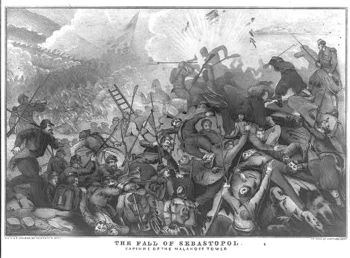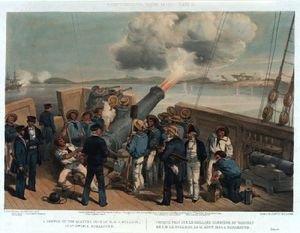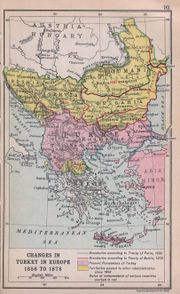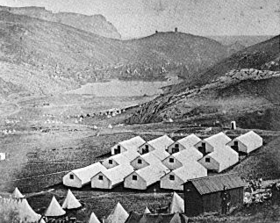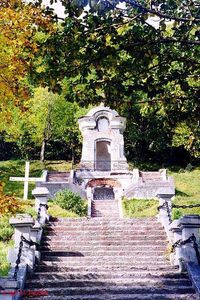Crimean War
2007 Schools Wikipedia Selection. Related subjects: Pre 1900 Military
| Crimean War | |||||||
|---|---|---|---|---|---|---|---|
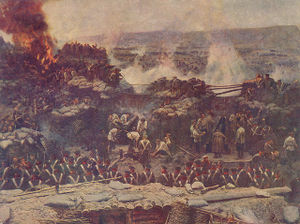 Detail of Franz Roubaud's panoramic painting The Siege of Sevastopol (1904). |
|||||||
|
|||||||
| Combatants | |||||||
| Allies: |
|||||||
| Casualties | |||||||
| 90,000 French 35,000 Turkish 17,500 British 2,050 Sardinian killed, wounded and died of disease |
~134,000 killed, wounded and died of disease |
||||||
| Crimean War |
|---|
| Sinop – Petropavlovsk – Alma – Sevastopol – Balaclava – Inkerman – Eupatoria – Taganrog – Chernaya River – Kars – Malakhoff – Kinburn - Kurekdere |
The Crimean War ( 1854– 1856) was fought between Imperial Russia on one side and an alliance of France, the United Kingdom, the Kingdom of Sardinia, and the Ottoman Empire on the other. The majority of the conflict took place on the Crimean peninsula, with additional actions occurring in western Turkey, the Baltic Sea region, and in the Russian Far East.
The war is generally seen as the first modern conflict and "introduced technical changes which affected the future course of warfare."
Buildup to war
Conflict over the Holy Land
The chain of events leading to Britain and France declaring war on Russia on March 28, 1854 can be traced to the 1851 coup d'état in France. Napoleon III had his ambassador to the Ottoman Empire, Marquis de Lafayette, force the Ottomans to recognize France as the "sovereign authority" in the Holy Land.
Quickly, the Russians made counterclaims to this newest change in "authority" in the Holy Land. Pointing to two more treaties, one in 1757 and the other in 1774, the Ottomans reversed their earlier decision, renouncing the French treaty and insisting that Russia was the protector of the Christian faith in the Ottoman Empire. Napoleon III responded with a show of force, sending the ship of the line Charlemagne to the Black Sea, a "clear violation" of the London Straits Convention. France's startling show of force, combined with aggressive diplomacy and money, changed Sultan Abdülmecid I's mind on the matter of the Holy Land and its protection. The newest treaty, between France and the Ottomans, confirmed France and the Catholic Church as the supreme Christian organization in the Holy Land, supreme control over the various Christian holy places, and gave the keys to the Church of the Nativity, previously in the hands of the Greek Orthodox Church, to the Catholic Church.
Due to his stunning diplomatic success in Constantinople, Napoleon III's support in France grew tremendously. However, Napoleon appeared to misjudge the religious convictions of Tsar Nicholas I. Angry over losing the diplomatic war to France in the Porte, the Russian tsar had his 4th and 5th Army Corps mobilized and deployed along the Danube River and had Count Karl Nesselrode, his foreign minister, begin a diplomatic war to regain Russian prestige with the Ottomans. As Nesselrode, a veteran diplomat, began forming his strategy for the tsar, he privately confided to the British ambassador in Saint Petersburg, Sir Hamilton Seymour:
[The row over the Holy Places] had assumed a new character - that the acts of injustice towards the Greek church which it had been desired to prevent had been perpetrated and consequently that now the object must be to find a remedy for these wrongs. The success of French negotiations at Constantinople was to be ascribed solely to intrigue and violence - violence which had been supposed to be the ultima ratio of kings, being, it had been seen, the means which the present Ruler of France was in the habit of employing in the first instance.
As conflict loomed over the question of the Holy Places, Nicholas I and Nesselrode began a diplomatic offensive which they hoped would prevent either Britain or France from interfering in any conflict between Russia and the Ottomans, as well as to prevent them from allying together.
Nicholas began courting Britain through Seymour. Nicholas insisted that he no longer wished to expand Imperial Russia further, but that he had an obligation to Christian communities in the Ottoman Empire.
The Tsar next dispatched a diplomat, Prince Menshikov, on a special mission to the Porte. By previous treaties, the Sultan was committed "to protect the Christian religion and its Churches", but Menshikov attempted to negotiate a new treaty, under which Russia would be allowed to interfere whenever it deemed the Sultan's protection inadequate. Further, this new synod, a religious convention, would allow Russia to control the Orthodox Church's hierarchy in the Ottoman Empire. Menshikov arrived at Constantinople on 16 February on the steam-powered warship Gromovnik. Menshikov wasted no time in breaking protocol at the Porte when, at his first meeting with the Sultan, he condemned the Ottoman's concessions to the French. Menshikov also began demanding the replacement of highly-placed Ottoman civil servants.
The British embassy at Istanbul at the time was being run by Hugh Rose, chargé d'affaires for the British. Using his considerable resources within the Ottoman Empire, Rose gathered intelligence on Russian troop movements along the Danube frontier, and became concerned about the extent of Menshikov's mission to the Porte. Rose, using his authority as the British representative to the Ottomans, ordered a British squadron of warships to depart early for an eastern Mediterranean cruise and head for Istanbul. However, Rose's actions were not backed up by the British admiral in command of the squadron, Whitley Dundas, who resented the diplomat for believing he could interfere in the Admiralty's business. Within a week, Rose's actions were cancelled. Only the French sent a naval task force to support the Ottomans.
First hostilities
At the same time, however, the British government of Prime Minister Aberdeen sent Lord Stratford. Through skillful diplomacy, Lord Stratford convinced the Sultan to reject the treaty, which compromised the independence of the Turks. Benjamin Disraeli blamed Aberdeen and Stratford's actions for making war inevitable, thus starting the process by which Aberdeen would be forced to resign for his role in starting the war. Shortly after he learned of the failure of Menshikov's diplomacy, the Tsar marched his armies into Moldavia and Wallachia (Ottoman principalities in which Russia was acknowledged as a special guardian of the Orthodox Church), using the Sultan's failure to resolve the issue of the Holy Places as a pretext. Nicholas believed that the European powers, especially Austria, would not object strongly to the annexation of a few neighbouring Ottoman provinces, especially given Russian involvement in suppressing the Revolutions of 1848.
When the Tsar sent his troops into Moldavia and Wallachia (the " Danubian Principalities"), Great Britain, seeking to maintain the security of the Ottoman Empire, sent a fleet to the Dardanelles, where it joined another fleet sent by France. At the same time, however, the European powers hoped for a diplomatic compromise. The representatives of the four neutral Great Powers—Great Britain, France, Austria and Prussia—met in Vienna, where they drafted a note which they hoped would be acceptable to the Russians and Ottomans. The note met with the approval of Nicholas I; it was, however, rejected by Abd-ul-Mejid I, who felt that the document's poor phrasing left it open to many different interpretations. Great Britain, France and Austria were united in proposing amendments to mollify the Sultan, but their suggestions were ignored in the court of Saint Petersburg.
Great Britain and France set aside the idea of continuing negotiations, but Austria and Prussia did not believe that the rejection of the proposed amendments justified the abandonment of the diplomatic process. The Sultan proceeded to war, his armies attacking the Russian army near the Danube. Nicholas responded by dispatching warships, which destroyed a squadron of Ottoman frigates in northern Turkey at the Battle of Sinop on November 30, 1853. The destruction of the Turkish fleet and heavy Ottoman casualties alarmed both Great Britain and France, which stepped forth in defence of the Ottoman Empire. Late in March of 1854, after Russia ignored an Anglo-French ultimatum to withdraw from the Danubian Principalities, Great Britain and France declared war.
Peace attempts
Nicholas felt that because of his services rendered in 1848, Austrians would side with him, or at the very least remain neutral. Austria, however, felt threatened by the Russian troops. When Great Britain and France demanded the withdrawal of Russian forces from the principalities, Austria supported them; and, though it did not immediately declare war on Russia, it refused to guarantee its neutrality.
Though the original grounds for war were lost when Russia withdrew its troops, Great Britain and France continued with hostilities. Determined to address the Eastern Question by putting an end to the Russian threat to the Ottoman Empire, the allies proposed several conditions for a peaceful resolution, including:
- Russia was to give up its protectorate over the Danubian Principalities;
- it was to abandon any claim granting it the right to interfere in Ottoman affairs on the behalf of the Orthodox Christians;
- the Straits Convention of 1841 was to be revised;
- all nations were to be granted access to the Danube River.
When the Tsar refused to comply with the Four Points, the Crimean War commenced.
Crimean War
Siege of Sevastopol
The following month, though the immediate cause of war was withdrawn, allied troops landed in the Crimea and besieged the city of Sevastopol, home of the Tsar's Black Sea fleet and the associated threat of potential Russian penetration into the Mediterranean.
The Russians had to scuttle their ships, and used the naval cannons as additional artillery and the ships' crews as marines. During the siege the Russians lost four 110- or 120-gun 3-decker ships of the line, twelve 84-gun 2-deckers and four 60-gun frigates in the Black Sea, plus a large number of smaller vessels. Admiral Nakhimov suffered a mortal bullet wound to the head, inflicted by sniper Benjamin Schneider, and died on 30 June 1855. The city was captured in September 1855, after about a year-long siege.
In the same year, the Russians besieged and occupied the Turkish fortress of Kars (the Battle of Kurekdere had been fought between the two in the same general area the year before).
Baltic theatre

The Baltic was a forgotten theatre of the war. The popularisation of events elsewhere has overshadowed the overarching significance of this theatre, which was close to the Russian capital. From the beginning, the Baltic campaign turned into a stalemate. The outnumbered Russian Baltic Fleet confined its movements to the areas around fortifications. At the same time, British and French commanders Sir Charles Napier and Parseval-Deschènes – although they led the largest fleet assembled since the Napoleonic Wars – considered Russian coastal fortifications, especially the Kronstadt fortress, too well-defended to engage and limited their actions to blockade of Russian trade and small raids on less protected parts of the Finnish coast.
Russia was dependent on imports for both the domestic economy and the supply of her military forces and the blockade seriously undermined the Russian economy. Raiding by allied British and French fleets destroyed forts on the Finnish coast including Bomarsund on the Åland Islands and Fort Slava. Other such attacks were not so successful, and the poorly planned attempts to take Hanko, Ekenäs, Kokkola and Turku were repulsed.
The burning of tar warehouses and ships in Oulu and Raahe led to international criticism, and in Britain, a Mr Gibson demanded in the House of Commons that the First Lord of the Admiralty explain a system which carried on a great war by plundering and destroying the property of defenceless villagers. In the autumn, a squadron of three British warships led by HMS Miranda left the Baltic for the White Sea, where they shelled Kola (which was utterly destroyed) and the Solovki. Their attempt to storm Arkhangelsk proved abortive, as was the siege of Petropavlovsk in Kamchatka. Here, an Anglo-French naval squadron successfully shelled the town but a Naval Brigade of 800 sailors and marines landed the next day was repulsed.
In 1855, the Western Allied Baltic Fleet tried to destroy heavily defended Russian dockyards at Sveaborg outside Helsinki. More than 1,000 enemy guns tested the strength of the fortress for two days. Despite the shelling, the sailors of the 120-gun ship Rossiya, led by Captain Viktor Poplonsky, defended the entrance to the harbour. The Allies fired over twenty thousand shells but were unable to defeat the Russian batteries. A massive new fleet of more than 350 gunboats and mortar vessels was prepared, but before the attack was launched, the war ended.
Part of the Russian resistance was credited to the deployment of newly created blockade mines. Modern naval mining is said to date from the Crimean War: " Torpedo mines, if I may use this name given by Fulton to self-acting mines underwater, were among the novelties attempted by the Russians in their defenses about Cronstadt and Sebastopol", as one American officer put it in 1860.
Pacific
Minor naval skirmishes also occurred in the Far East, where a strong British and French Allied squadron under Rear Admiral David Price and Contre-admiral Febrier-Despointes besieged a smaller Russian force under Rear Admiral Yevfimy Putyatin at Petropavlovsk on the Kamchatka Peninsula. An Allied landing force was beaten back with heavy casualties in September 1854, and the Allies withdrew. The Russians escaped under snow in early 1855 after Allied reinforcements arrived in the region.
Italian Involvement
With the Italian Unification campaign going on at the time in the Italian states, Camillo di Cavour under orders by Victor Emmanuel II of the Kingdom of Sardinia sent troops to side with French and British forces during the war. This was an attempt at gaining the favour of the French especially when the issue of uniting Italy under the Sardinian throne would become an important matter. The deployment of Italian troops to the Crimea allowed Piedmont to be represented at the peace conference at the end of the war, where it could address the issue of the risorgimento to other European powers.
End of the war
Peace negotiations began in 1856 under Nicholas I's son and successor, Alexander II. Furthermore, the Tsar and the Sultan agreed not to establish any naval or military arsenal on the Black Sea coast. The Black Sea clauses came at a tremendous disadvantage to Russia, for it greatly diminished the naval threat it posed to the Turks. Moreover, all the Great Powers pledged to respect the independence and territorial integrity of the Ottoman Empire.
The Treaty of Paris stood until 1871, when France was crushed by the German states in the Franco-Prussian War of 1870–1871. Whilst Prussia and several other German states united to form a powerful German Empire, the Emperor of the French, Napoleon III, was deposed to permit the formation of a French Republic. During his reign (which began in 1852), Napoleon III, eager for the support of Great Britain, had opposed Russia over the Eastern Question. Russian interference in the Ottoman Empire, however, did not in any significant manner threaten the interests of France. Thus, France abandoned its opposition to Russia after the establishment of a Republic. Encouraged by the decision of the French, and supported by the German minister Otto, Fürst von Bismarck, Russia denounced the Black Sea clauses of the treaty agreed to in 1856. As Great Britain alone could not enforce the clauses, Russia once again established a fleet in the Black Sea.
Having abandoned its alliance with Russia, Austria was diplomatically isolated following the war. This led to its defeat in the 1866 Austro-Prussian War and loss of influence in most German-speaking lands. Soon after, Austria would ally with Prussia as it became the new state of Germany, creating the conditions that would lead to World War I.
Characteristics of the war
The war became infamously known for military and logistical incompetence. However, it is important to note the work of women who served as army nurses. The scandalous treatment of wounded soldiers in the desperate winter that followed was reported by war correspondents for newspapers, prompting the work of Florence Nightingale and others and introducing modern nursing methods.
Amongst the new techniques used to speed the treatment of wounded soldiers, a primitive form of ambulance was used for the first time during this conflict.
The Crimean War also introduced the first tactical use of railways and other modern inventions such as the telegraph. The Crimean War is also credited by many as being the first modern war, employing trenches and blind artillery fire (gunners often relied on spotters rather than actually being on the battlefield). The use of the Minié ball for shot, coupled with the rifling of barrels, greatly increased Allied rifle range and damage. This was the second war ever photographed, after the Mexican-American War.
The Crimean War occasioned the introduction of hand rolled "paper cigars" — cigarettes — to French and British troops, who copied their Turkish comrades in using old newspaper for rolling when their cigar-leaf rolling tobacco ran out or dried and crumbled.
It has been suggested that the Russian defeat in the Crimean War may have been a factor in the emancipation of Russian serfs by Tsar Alexander II in 1861.
The British Army abolished Sale of commissions as a direct result of the disaster at the Battle of Balaclava, which saw the ill-fated Charge of the Light Brigade.
Major events of the war
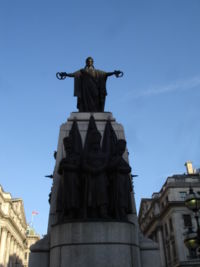
- Some action also took place on the Russian Pacific coast, Asia Minor, the Baltic and White Seas
- The roots of the war lay in the existing rivalry between the British and the Russians in other areas such as Afghanistan ( The Great Game). Conflicts over control of holy places in Jerusalem led to aggressive actions in the Balkans, and around the Dardanelles.
- Major battles
- Destruction of the Ottoman fleet at Sinop - 30 November 1853
- The Battle of Alma - 20 September 1854
- Siege of Sevastopol (also known as, " Sebastopol") - 25 September 1854 to 8 September 1855
- The Battle of Balaclava - 25 October 1854 (see also Charge of the Light Brigade)
- The Battle of Inkerman - 5 November 1854
- Battle of Eupatoria, 17 February 1855
- Battle of Chernaya River (aka "Traktir Bridge") - 25 August 1855
- Highly successful Anglo-French naval campaign in the Sea of Azoff (Azov), May to November 1855
- Siege of Kars, June to 28 November 1855
- It was the first war where the electric telegraph started to have a significant effect, with the first 'live' war reporting to The Times by William Howard Russell, and British generals' reduced independence of action from London due to such rapid communications. Newspaper readership informed public opinion in the United Kingdom and France as never before.
- Florence Nightingale and Mary Seacole came to prominence for their contributions in the field of nursing during the war.
Prominent military commanders
- Russian commanders
- Mikhail Dmitriyevich Gorchakov
- Ivan Feodorovich Paskevich
- Pavel Stepanovich Nakhimov
- Eduard Ivanovich Totleben
- Aleksandr Sergeyevich Menshikov
- British commanders
- Earl of Cardigan
- Lord Raglan
- Sir Thomas James Harper
- Sir Edmund Lyons (later 1st Lord Lyons)
- French commanders
- Jacques Leroy de Saint Arnaud
- François Certain Canrobert
- Ottoman commanders
- Abdülkerim Nadir Pasha
- Omar Pasha
Crimean War in fiction
- The song " The Trooper" by English metal band Iron Maiden is about the Crimean War.
- The Charge of the Light Brigade by Alfred, Lord Tennyson depicted a disastrous but brave cavalry charge during the Battle of Balaclava.
- Leo Tolstoy wrote a few short sketches on the Siege of Sevastopol, collected in The Sebastopol Sketches. The stories detail the lives of the Russian soldiers and citizens in Sevastopol during the siege. Because of this work, Tolstoy has been called the world's first war correspondent.
- In the Thursday Next series of novels by Jasper Fforde, which are set in an alternative reality, the Crimean War lasts 132 years from 1853 to 1985, and creates sour relations between Imperial Russia and England. The protagonist of the series, Thursday Next, fought in the conflict.
- Beryl Bainbridge's novel Master Georgie is set in the Crimean War.
- George MacDonald Fraser's novel Flashman at the Charge (1986) is also set in the Crimean War.
- Stephen Baxter's novel Anti-Ice starts with the siege of Sevastopol, which is shortened dramatically by a new Anti-Ice weapon. The book asks the question - what if nuclear weapons had existed in Victorian times?
- The song " Abdul Abulbul Amir" by Irish music hall performer Percy French was inspired by the Crimean War and reduces it to two fighters, the Turk Abdul and the Russian soldier Ivan Skavinsky Skivar, who duel over a triviality and both die, accomplishing nothing.
- "Luck", by Mark Twain, mentions the Crimean War in connection with a celebrated war hero.
- The Great Stink by Clare Clark, debut novel published 2006, tells the story of a traumatized veteran of the Crimean War and contains a number of references and flashbacks to this conflict.
- The Irish music song " The Kerry Recruit" deals with the experiences of a young man from Kerry who fights in the war.
- Crime Fiction author Anne Perry's William Monk novels include commentaries on the Crimean War through the eyes of the character Hester Latterly, 'one of Miss Nightingale's nurses'.
- "Hope" by Lesley Pearse describes the experiences of a nurse in the Crimean War as part of a wider and longer plot.
- The music video for Kasabian song Empire is set during the Crimean War - with the band members as British infantrymen. It was shot on location outside of Bucharest.

